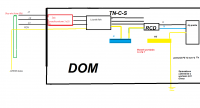Hello,
I am asking for opinions on the modification of the installation system at home and in the 70s TN-C on TN-CS.
Parts of the installation, where there is no RCD yet, still works in the TN-C system (2 wires) with the bridging of the pins with the PEN conductor. They are separate circuits.
On the other hand, the layout in the basement of the house, where I have what is most important, a washing machine, a central heating stove, a gas stove, a laundry room, ironing, etc. - modified to TN-CS
In such a system, does N and PE bridging (fig) improve the safety of use and should it be done? ... because what if the PEN is broken on the pole -> house line?
A ground with a resistance of 4.91 Ohm measured by an electrician from ZE, who commented on it in such a way that I will improve their network statistics by bridging N and PE
Currently, RCDs work without this bridge and an attempt to connect the pin and the N wire in the sockets ends with a quick disconnection by a given differential of a given circuit. I have 3 for the basement itself, for the stove, a separate for the washing machine, etc.
Of course, the circuits are protected with overcurrent B16 A, sockets and B6 A lighting.
I am asking for opinions on the modification of the installation system at home and in the 70s TN-C on TN-CS.
Parts of the installation, where there is no RCD yet, still works in the TN-C system (2 wires) with the bridging of the pins with the PEN conductor. They are separate circuits.
On the other hand, the layout in the basement of the house, where I have what is most important, a washing machine, a central heating stove, a gas stove, a laundry room, ironing, etc. - modified to TN-CS
In such a system, does N and PE bridging (fig) improve the safety of use and should it be done? ... because what if the PEN is broken on the pole -> house line?
A ground with a resistance of 4.91 Ohm measured by an electrician from ZE, who commented on it in such a way that I will improve their network statistics by bridging N and PE
Currently, RCDs work without this bridge and an attempt to connect the pin and the N wire in the sockets ends with a quick disconnection by a given differential of a given circuit. I have 3 for the basement itself, for the stove, a separate for the washing machine, etc.
Of course, the circuits are protected with overcurrent B16 A, sockets and B6 A lighting.




